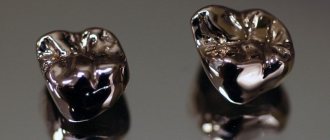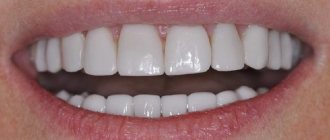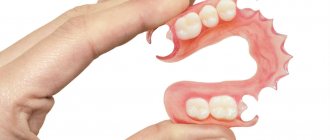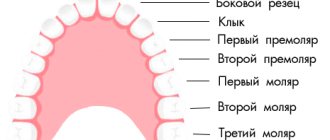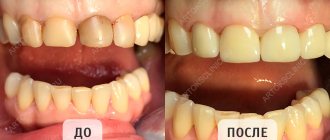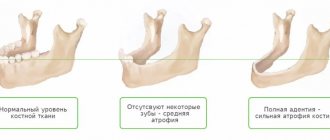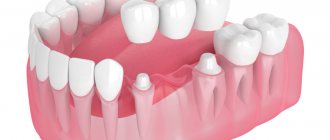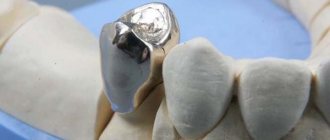We will describe in detail which crowns are best to place on chewing teeth and which on the front teeth. Our specialists have been installing the best crowns at affordable prices for over 25 years.
Many patients, before visiting a specialist, study the types of dental crowns and seek to find out which ones are best suited for each specific situation. Most people rely on forums, others ask their friends questions about the results of prosthetics. Unfortunately, only a few manage to obtain real information.
This article provides comprehensive information regarding the different types of crowns, methods of their manufacture, performance characteristics, service life and pricing policy. We hope that while reading this material you will study in detail the types of crowns on teeth and be able to understand which ones are best suited for a particular area of the jaw.
For everyone who does not know where it is best to put crowns on their teeth , we offer services of the highest level. In our clinic, all procedures are carried out under the guidance of specialists with impressive experience and deep knowledge in the field of prosthetics. In addition, we focus on using only modern durable materials, high-precision dental equipment, and implement effective technological solutions. This allows each patient to count on high-quality and long-lasting treatment results.
Metal-plastic crowns
Such prostheses are called conditionally temporary crowns. A cost-effective prosthetics option that involves installing crowns with a metal base and a plastic coating. Traditionally, structures are made of nickel, cobalt, and chromium.
Despite the natural appearance and relatively good functionality, it is not worth wearing such prostheses for a long time: the product quickly loses its whiteness, slightly increases in size and needs to be replaced.
Among the undeniable advantages of metal plastic are its low cost and gentle effect on the enamel layer of the tooth. If the product is slightly deformed, it can be repaired directly in the patient’s mouth. Among the disadvantages of this choice, it is worth highlighting the low strength of the structure and the likelihood of developing allergies.
What are the consequences of untimely crown replacement?
1. Destruction of the tooth under the crown with its subsequent loss.
The main function of a crown is to restore a badly damaged tooth and protect it. The first time after installation, the crown performs its function perfectly. But after a certain time, changes occur. The gingival margin rises, saliva and gingival fluid affect the cement that “secures” the crown. Over time, this cement can be partially washed out (dissolved), a microscopic gap is formed between the crown and the tooth, and the tooth begins to deteriorate under the influence of microbes and oral fluid. The most insidious thing is that these signs occur asymptomatically and unnoticed by the patient, since they are painless. Therefore, replacement of crowns often occurs untimely, when the tooth is destroyed too much and becomes simply unreliable.
Associated with this is the myth that teeth under crowns are destroyed. The truth is that crowns are simply replaced at the wrong time, but too late.
This can be prevented by timely replacement of the orthopedic structure.
2. Inflammation of the tissues around the crown . This means the gums, tooth ligament and bone tissue. A poor-quality crown can lead to the formation of a chronic inflammatory process in the gums (gingivitis, periodontitis), which is manifested by redness, bleeding when brushing teeth, aching pain in the gums and an unpleasant odor. If such a crown is not replaced for a long time, the underlying tissues become involved in the inflammatory process, which may lead to the formation of bone pockets, disruption of the ligamentous apparatus of the tooth, and local periodontitis, which in severe cases leads to tooth loss.
Photo 2.1. Inflammation of the gums near teeth under crowns, associated with inaccurate marginal fit of the crown to the tooth and with a violation of the biological parameters of tooth restoration.
Important! Make it a rule to visit the dentist for a preventive examination at least once a year, if you have any dentures, in order to notice their failure in time and prevent or correct the problem.
Metal-ceramic crowns
Practice shows that metal-ceramic crowns are deservedly considered the most popular. The base of the product is metal (cobalt, chromium, titanium, gold, etc.). To give the crown an aesthetic appearance, the metal base is covered with a ceramic layer and the elements are connected by exposure to high temperatures.
The popularity of metal ceramics in prosthetics is explained by its obvious advantages:
- Aesthetics. The material with which the crown frame is covered completely recreates the anatomical structure of the enamel;
- Sufficient strength. The products are quite durable due to the cast metal frame - they can withstand normal chewing loads and do not wear out. It is rare to see chipping of the enamel coating. In this case, repair of the prosthesis can be done in the patient’s mouth;
- Versatility. Crowns of this type are installed both on individual fragments of a row, and in the form of a dental bridge.
Since the ceramic layer is completely opaque, the prosthetic fragment (especially with a single restoration) can stand out against the background of natural teeth. Another disadvantage of metal-ceramic crowns is the need to grind the unit, after which it forever loses its original shape.
Metal crowns
These are the predecessors of all other types of dentures. This type of prosthesis is indicated for installation only on chewing teeth, since the structures are noticeable on the front teeth. Metal crowns are made of steel, titanium, platinum, and gold. Alloys containing cobalt, chromium, and silver are also in demand.
In laboratory conditions, stamped or cast products with spraying are prepared for patients. Standard structures take on the desired shape as work progresses. Individual production of the cap guarantees maximum adherence to the tissues, which eliminates rapid abrasion of the material and the spread of bacteria under the prosthesis.
Among the advantages of such products, it is worth noting their exceptional strength (due to the plasticity of the material, a crown made of this type of material does not crack and does not wear out for a long time). However, metal dentures are extremely unaesthetic, can cause allergies, and are difficult to fit on a tooth.
In addition, when using metal prosthetics, it is worth considering that crowns made from several types of metal cannot be used at once. If the patient already has a steel structure in his mouth, in the future he will have to fix crowns only from this material. Otherwise, the patient may develop galvanic syndrome, which is manifested by a burning sensation in the mouth and a “metallic” taste.
If the tooth under the crown hurts.
Modern materials and technologies used in dentistry today make it possible to produce custom-sized crowns that fit as closely as possible to the tooth tissue. However, some patients complain that their crown hurts. Of course, this is impossible, and the crown cannot hurt, but the tooth underneath it can cause similar sensations.
The most common cause of such complaints is the development of secondary caries under the crown. The cause may also be poorly treated root canals of the tooth before installing a crown. If such a problem befalls you, be sure to consult a doctor to remove the old crowns, re-prepare the teeth and install new ones.
In Spartamed dentistry, it is also possible to treat a tooth through a crown using magnifying technology - a microscope. This service is offered by a few dentists in Omsk. Therefore, before deciding to remove the crown because the tooth hurts under the crown, contact the Spartamed dentists.
If you ignore pain signals and do not disturb the crown, you can easily lose a tooth.
There are two main reasons for the development of secondary caries under a denture:
1. Violation of the technology for making or installing the crown (loose fit, saliva getting under the crown, untreated caries, etc.)
2. Expiration of crown service life
Crowns do not last forever; they must be replaced. The service life of crowns varies, it all depends on the material from which it is made, the initial condition of the tooth, the technology used to install them, etc. At the end of its service life, if there is no damage on the crown itself, the cement on which it is glued is destroyed. So don’t repeat the most common mistake of all patients without exception who wear dentures; don’t ignore the service life of your crowns if you don’t want to join the army of those who are occupied with the question “What should I do if I swallowed a crown?” We would like to reassure all our patients in advance: the materials for making crowns are not toxic, but if swallowed, do not be lazy to consult a doctor.
Ceramic crowns for teeth
Metal-free crowns are deservedly recognized as the most aesthetic: they are extremely difficult to distinguish from natural teeth, even if the gum tissue becomes thinner, the prosthesis remains invisible and looks natural. In dentistry, several types of metal-free dental crowns are used:
- Porcelain or all-ceramic. They are made according to a personal impression from pressed material without adding other components.
- Mixed (zirconium dioxide and ceramics). They are stronger than the previous type of prosthesis, have high light transmittance and do not cause allergies.
- Mixed (aluminum oxide and ceramics). The designs are made of translucent hypoallergenic material, which is comfortable to wear and resistant to temperature changes.
All ceramic products are biologically compatible with mucous membranes and do not tend to cause allergic reactions. Other advantages of the designs include:
- light weight (a crown can be installed even on weakened teeth);
- immunity of ceramics to dyes;
- the need for minimal tooth grinding before ceramic prosthetics.
The disadvantages of this method of prosthetics include the relatively high cost of the products, as well as their fragility. Ceramic structures are not designed for significant chewing loads, which is why they are more often used for prosthetics of the upper incisors.
If you properly care for ceramic products, they will last from 10 to 15 years. At the same time, the prosthetic structure is not susceptible to caries and does not accumulate plaque.
Zirconium dioxide crowns
Zirconium crowns are prepared in laboratory conditions using high-precision computer equipment. Laser scanning allows for an accurate analysis of the dentition, after which a computer program models an accurate crown for the tooth. Optical data is transferred from the computer to a milling machine, which grinds the prosthesis from the workpiece.
These types of dental crowns are the most expensive. Their price is justified by a number of obvious advantages:
- Strength. Zirconium dioxide is as durable as natural tooth enamel. Even solid bridges can be made on the basis of this material;
- High aesthetics. The shade of zirconium dioxide can easily be matched to the color of the natural enamel layer;
- Biological compatibility. Zirconium dioxide is safe for human health. This type of prosthetics is not contraindicated for patients with metal allergies.
The products are recommended for installation by patients who have high demands on the appearance of structures and want their new teeth to be indistinguishable from natural elements.
What types of prostheses are there, which ones are better to install?
Crowns are fixed to the visible part of the element using a special dental compound. Prosthetics with crowns allows you to simultaneously restore chewing function and the anatomy of the dentition.
Teeth crowns differ in material and, accordingly, in price. To decide which crowns are best placed in a particular clinical case, you should outline the pros and cons of each type of prosthesis
Plastic crowns
Such products are used as temporary crowns. They are lightweight, quick to manufacture and inexpensive. The structures are fixed to ground teeth or implants (while the permanent prosthesis is being prepared).
The mission of temporary crowns is to evenly distribute the chewing load on the dentition, while reducing the risk of developing bone atrophy in the jaw and further accelerating the process of getting used to the permanent prosthetic structure.
Metal-plastic crowns
The most inexpensive option for prosthetics. The crown is based on a metal alloy (cobalt, chromium, nickel). To give the prosthesis a natural appearance, the base is covered with a layer of plastic. In case of minor chips in the material, the product can be repaired directly in the patient’s mouth.
Metal-plastic structures are not strong enough - they can last a person up to 3 years. Over time, products lose color, slightly increase in size, and can cause allergies.
Metal ceramics
Metal-ceramic crowns are the true “golden mean” - the products are quite reliable and aesthetic. The surface of the prosthesis is ceramic, and the base is a metal alloy.
When making dentures from precious metals (gold, silver, palladium), you can count on a more natural appearance of the structure. In this case, the metal base will not give off a grayish tint through the coating, as is the case with conventional metals.
The relatively low price of metal-ceramic prosthetics with its acceptable functional and aesthetic indicators makes this method of tooth restoration the most popular. However, before making a choice in favor of metal ceramics, it is worth considering the risk of developing an allergy to metal, as well as the minimal likelihood of chipping the ceramic coating.
Metal crowns
This type of prosthesis is less popular these days. The product looks like a metal cap that is placed on a damaged tooth or titanium root. The strength of these crowns is enviable. A significant disadvantage of such products is their unaesthetic appearance: metal in the oral cavity is difficult to hide from prying eyes.
The denture is made in a dental laboratory. The basis is steel, titanium, as well as gold and platinum. In dentistry, there are two types of metal crowns:
- stamped. These are standard caps that are given an individual shape in the patient’s mouth. The products have thin walls, so they wear out quickly and are very rarely used in practice;
- cast. The designs are prepared on the basis of personal casts. This technique makes it possible to produce dentures that fit perfectly to hard tissue, eliminating the spread of bacteria in the space between the denture and dental tissue.
In the process of manufacturing metal crowns, spraying technology is often used. The material for these purposes is chosen at the request of the patient (gold, zirconium dioxide, plate).
Metal-free crowns
This type of crown has the highest aesthetics - it is very difficult to distinguish them from natural teeth. The following materials can be used in the production of prostheses:
- porcelain or pressed ceramics. The most attractive looking crowns. They are inferior to their analogues in strength, but are absolutely safe for the patient - they have a high biocompatibility index;
- zirconium dioxide. A durable material that is superior to alternative options in aesthetics - teeth with such crowns look like natural ones in the mouth. Other advantages of zirconium dioxide crowns include: safety, resistance to breakage, long service life;
- aluminium oxide. This material is slightly lighter than zirconia, making it most preferred when restoring anterior teeth. Products made from aluminum oxide are hypoallergenic and do not change their shade.
Gold crowns on teeth
Separately, it is worth noting the type of metal crowns - gold products. In dentistry, pure material is not used in the manufacture of dentures, since gold is a soft metal. Traditionally, an alloy with palladium and platinum is used. The structures fit well, do not irritate the mucous membrane, and do not lead to bleeding gums.
Very often, gold dentures are coated with a ceramic layer. Such products can even be placed on the front teeth: they retain the beneficial properties of the base material and look good.
Types of Best Dental Crowns for 2022
Modern dentistry offers patients crowns made from various materials. It is this indicator that is key in determining the cost, quality parameters and indications for the use of a particular prosthesis. Another important criterion on which the quality of a product depends is the production method.
The following crowns are currently in demand:
- Metal-ceramic. They are among the most popular prosthetic devices. Includes a metal base and an outer facing layer of ceramics. Initially, the frame is made, after which the ceramic coating is performed. The production process can be carried out on the basis of modern computer programs and aesthetic modeling.
- All-ceramic. In the manufacture of such prostheses, metal-free ceramics are used. Provides maximum safety in relation to soft tissues, which is due to the biological inertness of this material. The manufacturing process is based on the firing technique; ceramic pressing technologies; use of milling equipment and modern digital programs.
- Crowns made of zirconium material. Despite its origin (metal), zirconium dioxide is famous for its unrivaled aesthetics and increased safety. The manufacturing process is based on the use of specialized digital programs and milling equipment. Two versions of such prostheses can be used: combined (include a base of zirconium material and ceramic lining) and monolithic (made of zirconium oxide without the use of a ceramic coating).
- Glass ceramics e.max. It is distinguished by perfect aesthetic parameters and the necessary strength. There are currently 2 material options in use: E.max RPESS - produced by injection molding using elevated pressure and temperature conditions, and E-max CAD - produced using modern digital applications and milling machines (CAD/CAM concept).
Temporary crowns on teeth
Since dental prosthetics requires time, the patient is often given temporary crowns. The patient wears the dentures until the permanent dentures are ready.
We are talking about inexpensive polymer, acrylic, and plastic crowns, which are designed to protect the prepared units from displacement and pathogens. In addition, they perfectly perform an aesthetic function, masking “holes” in the oral cavity.
Temporary crowns can be placed on natural teeth or on implants. Due to these structures, an even distribution of the chewing load is ensured, the risk of jawbone resorption is reduced, and the rate of adaptation to a permanent prosthesis is accelerated.
Is it possible to install a crown if there is no natural tooth?
In the absence of natural teeth, the integrity of the front row can be restored using implants. Carrying out implantation does not require turning of adjacent elements. The crown is placed immediately after the implantation of the artificial root. This process can last from 2 months to six months.
Before installing implants, the doctor takes impressions or conducts three-dimensional computer modeling to obtain a virtual model of the future structure. Before the permanent prosthesis is fixed, the doctor places a temporary crown on the patient.
Ranking of dental crowns by nomination
| The most | |
| Aesthetic | Unaesthetic |
| Zirconium | Metal |
| Durable | Short-lived |
| Zirconium/Metal | Metal-plastic |
| Biologically compatible | Unsafe for the body |
| Zirconium/Ceramic/Metal-ceramic with gold-platinum alloy frame | Nickel-based metal-ceramic |
What dentures are best for the front teeth?
Since the teeth in the smile area are visible to others, high aesthetic demands are placed on prosthetics in this area. In this regard, it is better to install prostheses made of zirconium dioxide (aluminum oxide), metal ceramics or all-ceramic crowns on the front teeth.
Caps made of solid ceramics are put on the upper incisors; they look good and are not subject to heavy loads. Products are made from medical porcelain using injection molding.
The lower incisors and canines bear a significant load, so in this case, solid ceramics are replaced with zirconium dioxide. The durable frame is coated with a ceramic layer to create a reliable and attractive prosthesis for the front teeth.
In addition, zirconium dioxide is successfully used when installing dental bridges in the smile area.
Prices for tooth crowns at Elident
When assessing dental crowns from the standpoint of which ones are better financially, one should take into account the material used, the technological solutions being implemented, the equipment used, as well as the level of professionalism of the specialist and the rating of the dental institution in which the teeth are restored.
The Elident clinic has affordable prices for all types of services related to the fixation of implants and the installation of dental crowns. At the same time, you can always count on an individual attitude and high professional training of dentists, which is combined with the use of highly effective innovative equipment and modern prosthetic concepts.
| Service | Price, ₽. |
| Consultation with an orthopedist | for free |
| Orthopantomogram - panoramic image of teeth | 950 |
| Ceramic crown Dutseram plus (Germany) | 20 500 |
| Ceramic crown made of zirconium dioxide | 35 000 25 000 |
| Empress crown | 19 000 |
| Ceramic crown made of zirconium dioxide on an implant | 35 000 |
| Temporary plastic crown/wedge. | 2300/1500 |
| Taking an impression from alginate mass | 400 |
| Diagnostic plaster model | 400 |
| Taking a double impression | 800 |
| Cementing inlays and crowns using Fuji cement | 700 |
| Cementing inlays and crowns using Fuji+ cement | 800 |
| Temporary cementation of one crown | 400 |
| Removing one crown with stamped sawing | 500 |
| Removing one crown with sawing the cast | 1 000 |
| Removing one crown with sawing MK | 800 |
What is better to put on chewing teeth?
Since the chewing teeth bear the bulk of the load, the crowns on them must be strong. Most often, metal-ceramic crowns are placed in the lateral sections. Metal ceramics are durable and aesthetic, but require significant grinding of dental tissue.
Zirconium dioxide has proven itself to be excellent. Its strength is comparable to the strength of metal crowns; only zirconium prostheses, unlike metal ones, are very similar to natural teeth. Another advantage of this choice is the insignificant grinding of tooth enamel before prosthetics.
All-metal crowns on teeth are cheaper. They have a long service life and are resistant to corrosion. An even more significant disadvantage of such prostheses (in addition to the low level of aesthetics) is the risk of developing an allergy to the material.
Duration of operation of different types of crowns
The most short-lived structures are made of metal-plastic. Therefore, they are traditionally used as temporary crowns. The maximum service life of products is 5 years. According to patient reviews, over time the plastic coating deforms and darkens.
Metal-ceramics is a practical option that is installed on both the front and chewing teeth. Such structures last up to 10 years.
Crowns made of medical porcelain do not darken or fade and can last up to 10-15 years. Throughout this period, the product looks like a natural tooth.
Crowns made of zirconium dioxide are considered even more stable: their service life is 15-20 years.
Prostheses made from precious metal alloys and products made from nickel are also durable and can last up to 15 years.
The service life of different types of crowns depends not only on the material, but also on the accuracy of installation. There should be no voids or gaps under a well-fixed crown. Otherwise, food debris will accumulate under the product, which over time will lead to the development of an inflammatory prosthesis.
Which ones are better to choose?
Clinics offer many options for crowns. One of the differences between them is the material used. It is on this parameter that the quality, cost, indications for the use of a particular crown and, of course, aesthetics largely depend. Another very important nuance that also affects the quality parameters is the manufacturing technology of the product.
Types of crowns
- Metal crowns.
They are considered hopelessly outdated. They can be made from various alloys (cobalt-chromium, nickel-chromium). Among the disadvantages are the not very aesthetic appearance, the risk of an allergic reaction to the metal. - Crowns made of precious metals.
As a rule, these are solid prostheses made of gold-platinum alloy. They allow you to achieve the necessary strength and maintain biocompatibility. However, crowns are not made entirely from this alloy. It is used as a frame for metal-ceramic crowns and is covered with ceramics on top. - Metal-ceramic crowns.
The most common products that consist of a metal frame and ceramic cladding. First, the frame is cast, then a layer of ceramic is applied, which can be manufactured using computer modeling. - All-ceramic crowns.
Metal-free ceramic crowns. Due to its biological inertness, this material is considered one of the safest for soft tissues. Manufactured using firing technology (on a refractory model or platinum foil); ceramic pressing method (surface painting technique or layering technique); on a milling machine using CAD/CAM computer modeling. - Zirconium dioxide crowns.
They are manufactured using computer modeling using special milling equipment. There are two types of zirconium dioxide crowns: monolithic (entirely made of zirconium dioxide without veneering) and combined (porcelain mass is applied to a zirconium dioxide frame). The presence of a frame allows you to hide darkened teeth, as well as existing metal inlays and pins. This gives the prosthesis more aesthetics.
There are also temporary crowns that are placed while the permanent structure is being manufactured, but we cannot talk about them as a full-fledged orthopedic structure.
Each of these types of crowns has variations within its category (type of alloy, material features, production method). The overall quality indicator consists of many nuances that must be taken into account when choosing a product. Below is a table with the main parameters that determine the quality of the crown. Two plus signs or two minus signs indicate a characteristic feature of the crown in a particular indicator.
Quality table
| Product | Strength | Aesthetics | Durability |
| Metal crown | + | – – | +/– |
| Golden crown | + | – | + |
| Metal-ceramic crown | +/– | +/– | +/– |
| Ceramic crown | + (depending on the type of crown) | ++ | + |
| Zirconium dioxide crown | + | + | ++ |
All types of crowns are capable of restoring the functionality of a tooth, but the appropriateness of choosing one or another product largely depends on the specific clinical case.
How to properly care for crowns
The method of caring for crowns is practically no different from the principles of caring for natural teeth and involves:
- performing oral hygiene twice a day (not only the teeth, but also the tongue should be brushed);
- cleaning the spaces between teeth and the space under dentures. To ensure the proper level of hygiene, it is preferable to use an irrigator: a directed jet helps to quickly and painlessly clean the space under the product;
- nutrition correction - excluding too hard foods and temperature changes from the menu;
- monitoring the condition of the gums and areas where teeth meet crowns (this is where caries most often develops);
- using mouth rinses after each meal (special formulations can be replaced with plain water).
Dentists also advise periodically massaging the gums under the structure. Soft tissues undergo increased pressure, so it is important to stimulate blood circulation in these areas. The gums should be massaged with smooth circular movements clockwise and counterclockwise.
Veneers or crowns: which is better?
You can restore your front teeth using veneers. Non-removable pads are attached to the turned elements. The procedure is much faster than prosthetics, but before making the final choice between veneers and crowns, consult your doctor. Durable ceramic onlays are classified as restoration methods in cosmetic (aesthetic) dentistry. Veneers that protect the surface of the tooth accurately imitate enamel, hiding all imperfections, but in case of significant damage and destruction they are not used. In these cases, crowns are installed.
How much does it cost to install a crown on a tooth?
The key criterion that determines the cost of prosthetics is the material used to make the prosthesis. If you arrange them from cheapest to most expensive, the list will look like this:
- metal-plastic;
- metal;
- gold;
- metal ceramics with ordinary metals;
- metal ceramics on a gold base;
- ceramics;
- zirconium dioxide.
In addition to the material, the price of the prosthesis is also influenced by the pricing policy of the clinic, the equipment used, and the qualifications of the attending physician. Some clinics manage to save money on prosthetics by installing crowns on several teeth at once.
It is impossible to accurately answer the question of which crown is best to install. The doctor makes the decision together with the patient. When choosing, emphasis is placed on clinical indications, characteristics of the patient’s jaw system, the state of oral health in general, the wishes and financial capabilities of the person.
Alternatives to a Dental Crown
Veneers are often preferred to crowns in the smile area. However, in this case, the back side of the elements should be more or less preserved.
Teeth can be restored using filling materials. This method can only be used if the destruction of the unit is not so global (less than half).
Judging by the reviews of doctors and patients, crowns are considered the optimal solution for significant damage to teeth, since they not only restore the functionality and aesthetics of a row, but also protect teeth from further destruction. An additional bonus of this type of prosthetics is the variability of materials and, accordingly, the cost of services.
Reviews from doctors and patients
Dentists consider dentures with crowns to be an excellent way to restore significantly damaged elements. Doctors note a significant advantage of this solution - it is an opportunity to prevent the destruction of a “dead” tooth or even preserve a “living” unit (if it is partially destroyed). This method cannot be called universal only because it has a number of contraindications, one of which is root damage.
Patients, for the most part, speak positively about prostheses of this type. They note the rapid restoration of functionality and aesthetics of the series, ease of use and durability of the prostheses.
